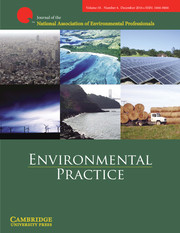Article contents
RESEARCH ARTICLE: Defining Appropriate Spatial and Temporal Scalesfor Ecological Impact Analysis1
Published online by Cambridge University Press: 09 February 2015
Abstract
Many environmental impact analyses, including those pursuant to theNational Environmental Policy Act of 1969, as amended, do not identify thespatial and temporal scales used in the analysis. Without definition ofanalytical scales, the reader is left to infer scale, which could confounddecision making when different readers infer different scales of analysis.For ecological analysis, site-specific spatial and temporal scales based onunique natural features and phenomena are most appropriate, given theinability of ecological resources to restrict themselves according topolitical boundaries or arbitrary time lines. Definition of scale in theenvironmental impact document allows the reader or decision maker toconsider the impacts in the intended context. Scales of ecological analysisshould be based on ecological principles as applied to a specific study areaand the ecological resources that may be affected by the proposed action oractivity. The multiscalar concept of biological connectivity should beaddressed in spatial and temporal analysis, which inherently includescross-scale considerations such as those for potential effects onmetapopulations. Definition of spatial and temporal scales is critical tobound the impact analysis and to inform readers and decision makers, andsuggested guidelines are provided as an example of an acceptable method.Although several different scales could be correctly chosen, analysts shouldidentify and define spatial and temporal scales used to promote consistentinterpretations of results and to facilitate the decision-makingprocess.
Environmental Practice 16: 281–286 (2014)
Information
- Type
- Features
- Information
- Copyright
- © National Association of Environmental Professionals 2014
Footnotes
The scientific results and conclusions, as well as any views or opinionsexpressed herein, are those of the author and do not necessarily reflectthose of the US Nuclear Regulatory Commission, the National Oceanic andAtmospheric Administration, or the Department of Commerce.
References
- 2
- Cited by

